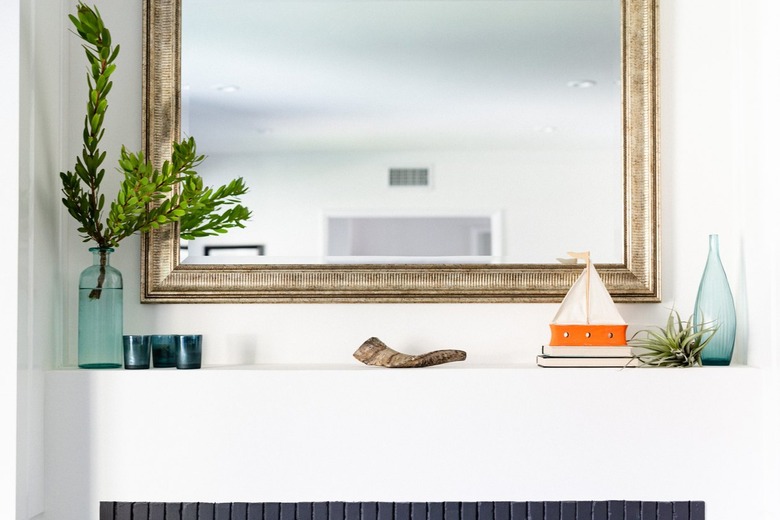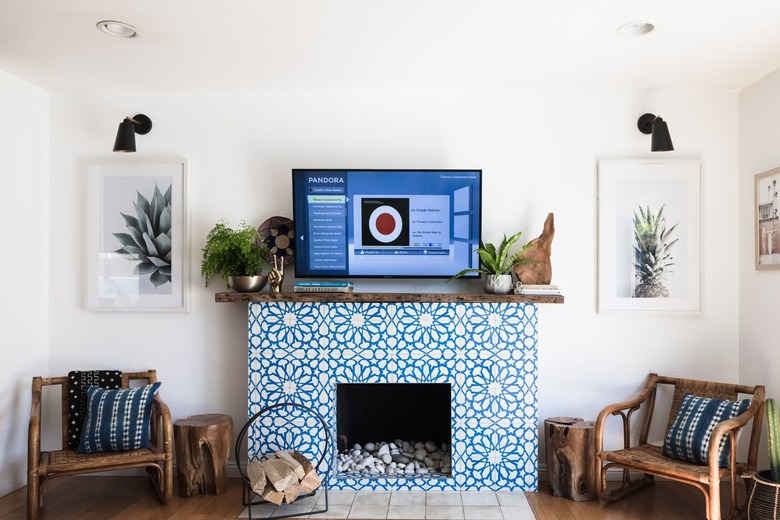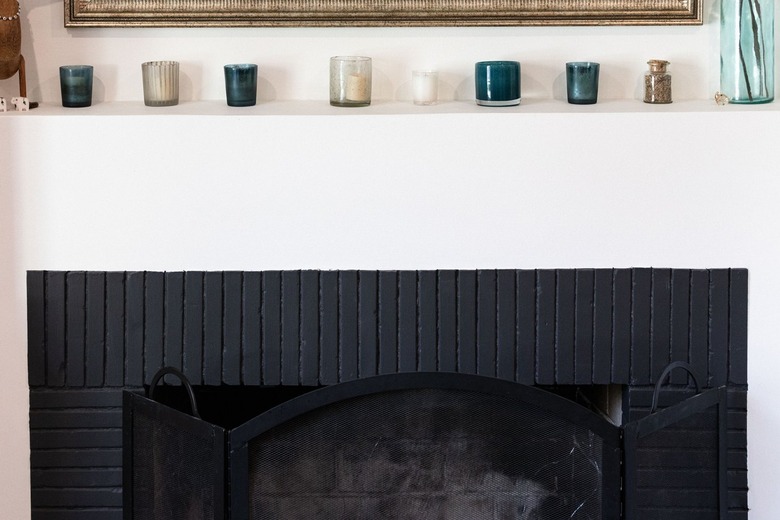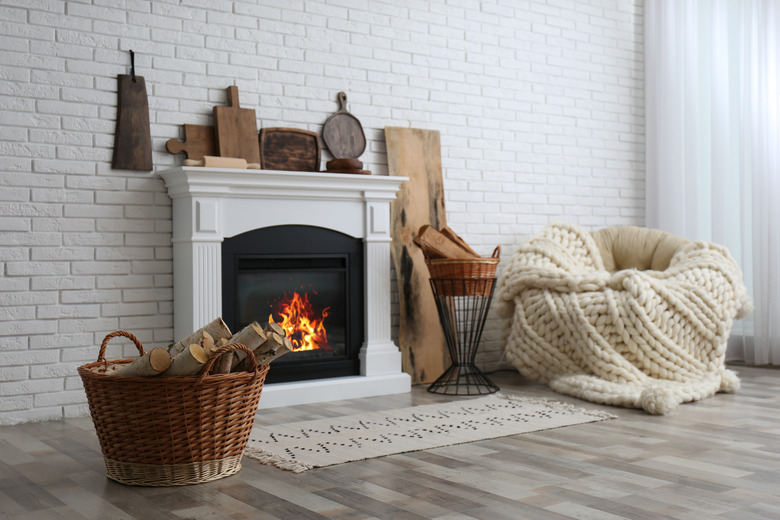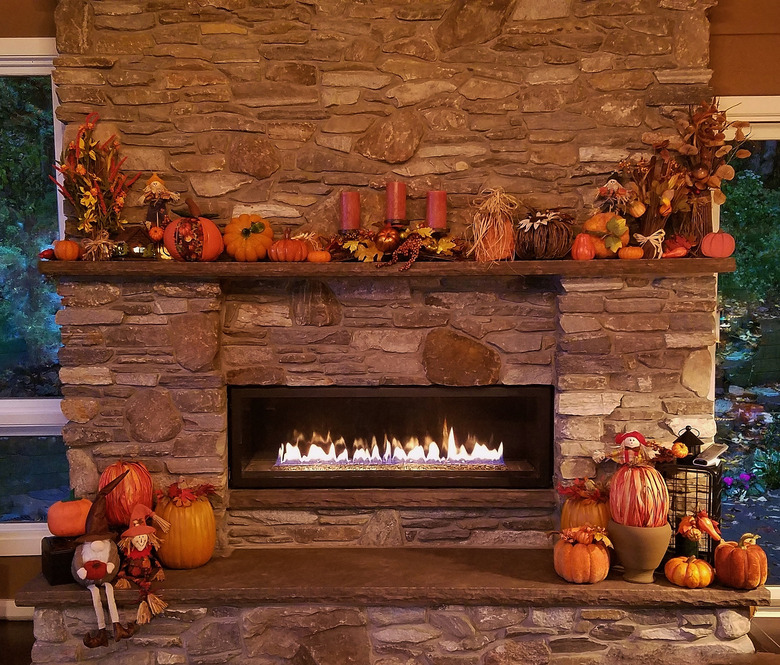How To Install A Fireplace Mantel
We may receive a commission on purchases made from links.
If you're searching for information about how to install a fireplace mantel, your motivation may be to provide a place to display knickknacks or hang holiday decorations. Beyond the endless decor possibilities it offers, a fireplace mantel highlights the fireplace as a focal point of the room and provides an aesthetic that hearkens back to the days when the fireplace was the prime gathering place for the household.
Strictly speaking, a mantel is essentially a shelf that overhangs the firebox, and it usually floats on the wall with no visible means of support. Some mantels incorporate support pillars that frame the firebox and extend to the floor. The design of others calls for corbels, which are decorative wooden brackets that support the shelf from underneath. But in most cases, the pillars and corbels are only for decoration — the mantel shelf is actually supported by posts or cleats installed on the wall above the fireplace.
If you're a savvy DIYer, you may want to make your own mantel out of new or reclaimed wood, or perhaps you've salvaged one from a historic building. If you're short on time (and/or energy), you may prefer to buy a mantel kit from a local or online supplier. Your kit should come with everything you need to support the mantel and instructions on how to complete the installation. Whether you make the mantel yourself or buy a kit, installation options vary depending on the material of the fireplace and surround.
Fireplace Mantel Installation Options
Fireplace Mantel Installation Options
A typical mantel is a hefty piece of lumber, or at least it looks that way when installed. Some mantels are hollow, constructed with standard lumber or sheet material (such as plywood or particleboard), and expertly finished in the factory to resemble a solid piece of wood. By virtue of being more lightweight and having space inside for support cleats, a hollow mantel is easier to install than a solid one. Here are the installation options for both solid and hollow mantels:
- Cleats: If you have a hollow mantel, the best way to install it is to fasten support cleats to the wall that will fit inside it. These cleats are typically lengths of 2x4 lumber that you attach to the wall with screws or bolts. Once they're in place, simply slip the mantel (and pillars if these are included in your kit) over the cleats and secure it with screws.
- Brackets: Some mantels come with brackets that you can attach to the wall. These mantels sometimes have mortises or grooves into which the brackets fit so you don't see them. You could theoretically mount the mantel directly on the corbels, but since that would create the necessity for visible bolts to hold the corbels, this design isn't common.
- Posts: The most common way to install a solid floating mantel (with no visible supports) is to drive support posts into the wall and drill holes in the back of the mantel so you can slide it onto the posts. A healthy dose of construction adhesive secures the mantel to the posts to ensure it doesn't slip off. This method works for mantels with or without corbels and pillars, and it's the most reliable method for installing a mantel on a brick or stone fireplace.
How to Install a Fireplace Mantel on Drywall
How to Install a Fireplace Mantel on Drywall
- Measure your preferred distance for the mantel above the fireplace using a tape measure and make a mark on the wall at that distance. Set a 4-foot level against the wall with its top edge on the mark, center the bubble, and trace a line along the edge for the full length of the mantel. If the mantel is long, you may need to reposition the level, and if so, make sure the bubble is centered before you extend the line.
- Use a stud finder to find the wall studs that intersect the mantel and mark their positions just above the line with a pencil. Make large marks that are easy to see; they will be hidden by the mantel.
- Mark the locations of the brackets or fasteners for the mantel. These locations depend on the mantel design and how it's supported; follow the manufacturer's instructions as applicable. It's best to secure each support into a wall stud, but if this is not possible, you can use a heavy-duty wall anchor, such as a toggle bolt.
- If the mantel design calls for a length of corner bracket, screw the bracket to the studs following the manufacturer's instructions. To mount with posts, drive 3/8- or 1/2-inch lag screws into the studs far enough to sink them at least 3/4 of their total length and then cut the heads off the bolts with an angle grinder. The bolts should extend far enough to sink at least halfway into the mantel. When installing with corner irons with decorative corbels, follow the manufacturer's instructions for attaching the corbels to the brackets and screw the brackets to studs. If you're mounting a hollow mantel with cleats, screw the cleats to the studs using 3-inch or longer screws and using a level to keep the cleats straight.
- Get a helper to help you mount the mantel. When using posts, position the mantel in front of them, make a mark for each one on the back of the mantel, and drill on the mark with a bit that has the same or a slightly larger diameter as the post. Squeeze some epoxy cement or construction adhesive into each hole, mount the mantel on the posts, and push it flush against the wall. Avoid putting weight on the mantel for 24 hours. When using cleats or brackets, set the mantel in position and screw it to the fasteners. If using cleats, you may have to screw through the top of the mantel, so make sure you use decorative brass screws that will add to the overall appearance.
- Although it isn't always necessary, you may want to fill the gap between the mantel and the wall with caulk. Use a clear caulk or one that matches the wall color. If you need to stain and finish the mantel, do that before you caulk.
Tip
If the design calls for wooden corbels, remember to raise the mantel high enough to get the proper clearance for the corbels.
How to Install a Fireplace Mantel on Brick
How to Install a Fireplace Mantel on Brick
The post method is the only one that works reliably for mounting a solid floating wood mantel on a brick or stone fireplace. Posts can be expansion bolts, 1/2- or 3/4-inch rebar, or galvanized steel pipe. They should be long enough to extend 3 inches into the brick and at least halfway into the mantel.
- Have a helper (or a pair of helpers if necessary) hold the mantel in position, making sure you leave the required clearance to the firebox. Set a 4-foot level on the mantel, adjust the mantel to center the bubble on the level, and make marks on the brick with a pencil at all four corners of the mantel. Remove the mantel and lay masking tape between the marks to indicate the top and bottom edges of the mantel. Use your level to make sure the tape is straight.
- Decide how many posts you need for stability (this will vary according to the weight and dimensions of the mantel). Drill a hole for each post using a hammer drill and a drill bit with a slightly larger diameter than the posts. The holes should be at least 3 inches deep and should be drilled into the brick — not the mortar — for extra stability.
- If you're using expansion bolts, tap one into each hole using a hammer, tighten down the nut to expand the expansion sleeve, and then remove the nut. When using rebar or steel pipe, fill each hole with adhesive and tap in the post.
- Have helpers hold the mantel in position, lining up the top and bottom edges with the tape on the brick and mark the positions of the posts on the back of the mantel. Drill a hole on each mark using a regular drill and a drill bit with the same or a slightly larger diameter as the post. The holes should be deep enough to allow the posts to sink at least halfway into the mantel.
- Fill each hole with adhesive. Remove the tape from the wall, lift the mantel into position, line up the holes with the posts, and push the mantel onto the posts. Keep pushing or tapping until the mantel rests flush against the brick. Don't put any weight on the mantel until the adhesive sets — usually about 24 hours. Caulk any gaps between the mantel and the brick if desired using a color-matched caulk.
How to Install a Fireplace Mantel on Stone
How to Install a Fireplace Mantel on Stone
The main difference between mantel installation on brick and stone is that the stone surface is usually irregular, and that may call for "hogging out" or shaping the back of the mantel to match the contours of the stone surface. It can be difficult to do this accurately, so it's best to hire an experienced professional to do it.
If the surface is relatively flat, installation is similar to installation on brick. Whether you drill the post holes in the stone or in the mortar between the stones depends on the nature of the stone. Some stone is very brittle and chips easily, in which case it's better to drill into the mortar. You may also want to drill into the mortar if the stone is extremely hard and difficult to drill.
